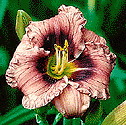
|
|
|
|
|
|

|
|
cascade a type of unusual form for which the tepals are recurving, kind of slightly curling backwards (a little bit like the segments would hang or like a waterfall) crispate a type of unusual form for which all of the 3 petals or 3 sepals are pinched, twisted/curled or quilled curled a sub-type of the Crispate unusual form for which normally the sepals (seldom the petals) show a corkscrew or pinwheel look deciduous plant completely redraws in winter, no green visible; may show a little bit of new shoot in late winter (other but wrong term would be dormant) diploid double set of chromosomes (2n) diurnal flower opens in the morning or forenoon dormant plant completely redraws in winter, no green visible; may show a little bit of new shoot in late winter (correct term would be deciduous) double flower has in the centre additional flower segments (mostly the pistil and/or the filaments are converted to segments; sometimes still having stigma and/or pollen) evergreen plant stays green in winter, but get injuried (maybe the lowest 10-15cm of the leaves really stay green to yellow) extended flower stays open for more than 12 hours fertile plant produces pods with seeds that are able to germinate nocturnal flower opens in the evening or night petals inner set of flower segments (the inner 3 flower segments) pinching a sub-type of the Crispate unusual form; the 3 petals are sharply folded back which results in a pinched/folded outlook pollen the male gametes of plants (similar to sperms for animals) polytepal the number of tepals is not 6 but more (like e.g. 8, 10 or 12; sometimes it is even an odd number), but the flower is not double (i.e. stamens and pistil exist; tepal number and stamen number should be the same) quilled a sub-type of the Crispate unusual form for which the sepals (seldom the petals) form a tubular shape along their lengths semi-evergreen redraws in winter almost completely, some small leaves may exist, new shoot mostly visible sepals outer set of flower segments (the outer 3 flower segments) spatulate a type of unusual form for which the petals are markedly wider towards their tips than close to their attachments at the other end spider the inner tepals (i.e. petals) have at least a ratio between width (not stretched) to length (stretched) of 1:4 tepals flower segments (inner and outer ones; acronym out of "petal") tetraploid quatro set of chromosomes (4n) triploid triple set of chromosomes (3n); is true only for a few species (not very fertile) twisted a sub-type of the Crispate unusual form for which normally the sepals (seldom the petals) show a corkscrew or pinwheel look unusual form all 3 sepals or all 3 petals have a special kind of forming (i.e. are not +/- flat); there are 3 types of unusual forms, namely Crispate, Cascade and Spatulate; the Crispates are further divided into Pinched Crispates, Twisted/Curled Crispates and Quilled Crispates USDA zone temperature zone mapping (please see the following page for more details: USDA Zone Map (under General Infos) | ||